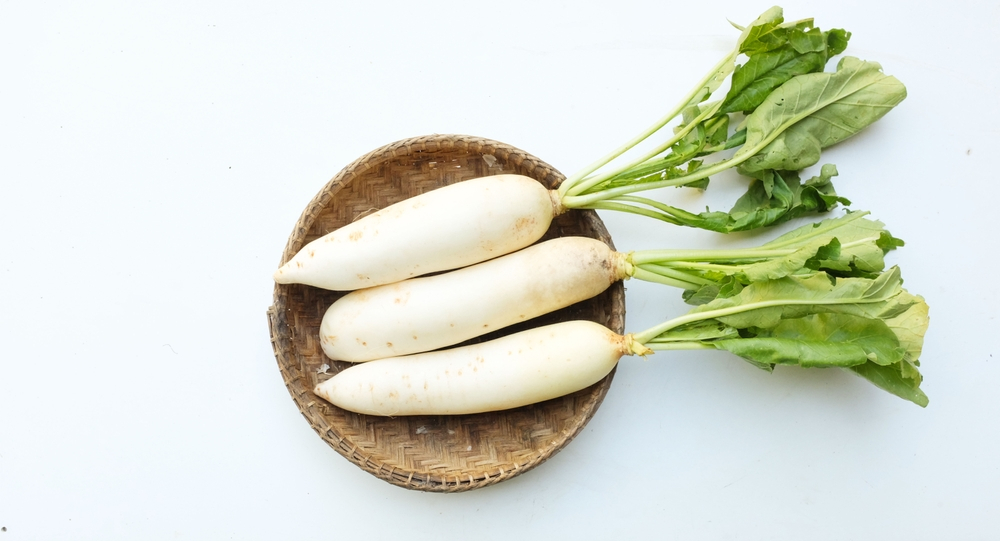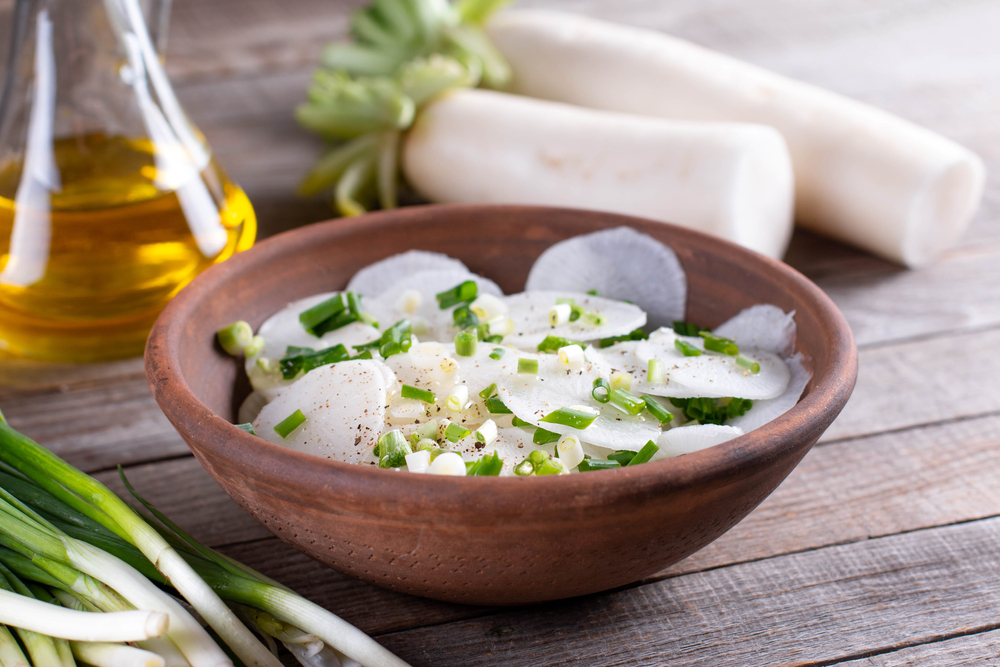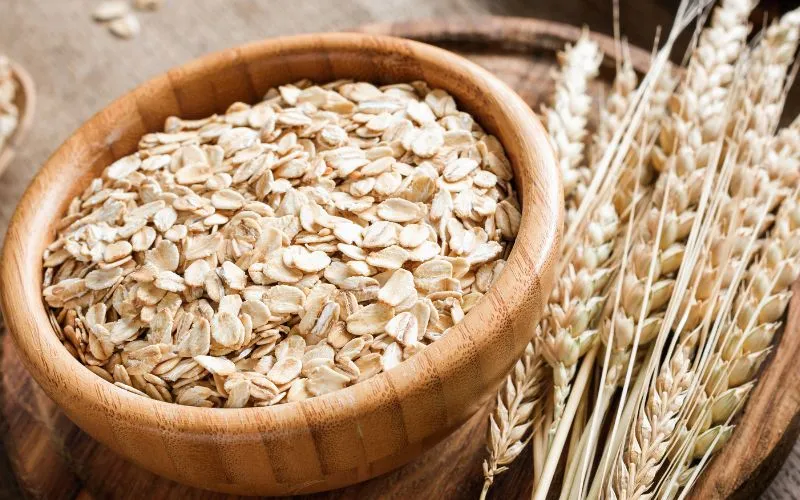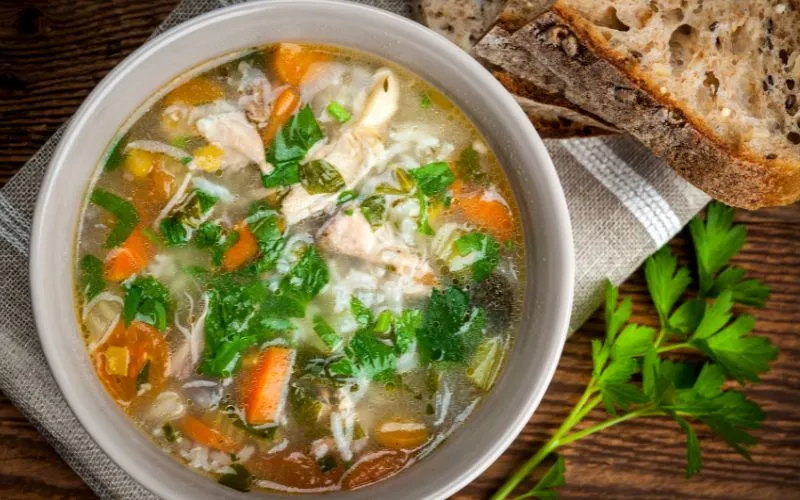- Home /
- Daikon Radish Benefits: Nutrition and Recipes Combined

Posted On:May 20th, 2024
Daikon Radish Benefits: Nutrition and Recipes Combined
Daikon, also known as white radish, Japanese radish, Chinese radish, winter radish, and luobo, is a staple in Japanese, Chinese, and other Asian cuisines. This vegetable, resembling a large white carrot, is commonly enjoyed raw, cooked, or pickled. Daikon radish’s crisp texture and mild flavor make it a versatile addition to salads and stir-fries. Beyond its culinary uses, daikon radish has numerous lesser-known benefits and applications. Let’s explore further!
Origins And History
The daikon radish, originating from the Mediterranean and Black Sea coasts, has been a staple in Asian cuisine. Historically, it was more than just food; it carried deep symbolic meanings and perceived medicinal properties. Ancient Greeks and Romans cultivated radishes using advanced methods like crop rotation and organic manures, showcasing early sustainable agriculture practices. As radishes spread to Asia, the daikon became integral to Japanese culinary traditions and symbolized prosperity and health.
Daikon Health Benefits
Daikon is rich in vitamin C and low in calories, making it a great addition to a weight-conscious diet. However, some people may experience radish allergies characterized by itching or swelling.
Nutrient-Rich
Daikon offers a substantial amount of potassium, comparable to three-quarters of that in a banana and half the vitamin C found in an orange.
Its high fiber content aids digestion and maintains a healthy gut. Additionally, daikon has anti-inflammatory properties. Here’s a quick look at its nutritional profile:
| Nutrient | Amount per 100g | % Daily Value* |
| Calories | 18 | <1% |
| Carbohydrates | 4.1g | 1% |
| Dietary Fiber | 2g | 8% |
| Vitamin C | 22mg | 24% |
| Calcium | 27mg | 2% |
*Percent Daily Values are based on a 2,000-calorie diet.
Promotes Wound Healing
Daikon radish is a rich source of vitamin C, an essential nutrient that aids in wound healing, collagen production, and overall skin health.
Protects Against Cell Damage
Vitamin C, present in daikon, acts as an antioxidant, protecting skin cells from damage caused by free radicals. Diets rich in cruciferous vegetables like daikon may lower the risk of cancer.
May Help Stabilize Blood Sugar
As a non-starchy vegetable, daikon has minimal carbohydrates, making it suitable for people with diabetes. Research indicates that consuming radishes like daikon can help prevent blood sugar spikes by slowing carbohydrate absorption.
Famous Daikon Radish Recipes
Incorporate daikon radish into your meals with these recipes:
Daikon And Krill Salad
A refreshing salad combining the crisp texture of daikon with the savory taste of Antarctic krill.
Ingredients: Thinly sliced daikon, cooked krill meat, lime dressing, cilantro, chili
Preparation
- Slice daikon thinly and place in a bowl.
- Add cooked krill meat that you can order from krillantarcticfoods.com.
- Drizzle with lime dressing and toss to coat.
- Garnish with chopped cilantro and a hint of chili.
Daikon Radish Cake
A savory cake made with grated daikon steamed and pan-fried to perfection.
Ingredients: Grated daikon, rice flour, soy sauce, sambal
Preparation
- Mix grated daikon with rice flour.
- Form into small cakes.
- Steam the cakes until firm.
- Pan-fry until crispy and golden.
- Serve with soy sauce and a side of sambal.
Japanese Daikon Miso Soup
A comforting miso soup featuring daikon and tofu in a rich, savory broth.
Ingredients: Sliced daikon, miso paste, tofu, seaweed
Preparation
- Heat water in a pot and dissolve miso paste.
- Add sliced daikon and cook until tender.
- Stir in tofu and seaweed.
- Simmer for a few minutes.
- Serve hot.
Daikon Kimchi
A spicy, fermented kimchi with crisp daikon radish as the star ingredient.
Ingredients: Sliced daikon, chili paste, garlic, ginger, salt
Preparation
- Mix sliced daikon with salt and let it sit for a few hours.
- Rinse and drain the daikon slices.
- Combine with chili paste, minced garlic, and ginger.
- Mix thoroughly.
- Pack into a jar and let ferment for a few days.
- Enjoy as a side dish or condiment.
Growing And Harvesting Of Daikon Radish
To grow daikon radish successfully:
- Soil Preparation: Use well-draining soil enriched with organic compost.
- Planting: Sow daikon seeds in late summer or early autumn.
- Watering: Water consistently, about one inch per week.
- Pest Management: Use natural remedies like neem oil for pest control.
- Harvesting: Harvest 50-70 days after planting when radishes are about 2 inches in diameter and up to 18 inches long.
Buying And Storage Tips
Select the freshest daikon radish and store it properly:
- Seasonal Availability: It is best buy during fall and winter.
- Market Selection: Choose firm, smooth daikons without blemishes.
- Storage: Wrap it in a paper towel, place it in a plastic bag, and store the daikon in the refrigerator crisper drawer. Peel, slice, or shred, and freeze in airtight containers for large quantities.
Conclusion
From its ancient roots to modern cuisine, daikon radish offers impressive nutritional benefits and versatile culinary uses. Whether you’re growing it, cooking it, or preserving it, daikon radish adds a fresh, crisp flavor to your dishes. Try incorporating it into your meals and enjoy its numerous health benefits.
Frequently Asked Questions
Can You Eat Daikon Radish Raw?
Yes, daikon radish can be eaten raw. It is often added to salads or used as a crunchy garnish in various dishes.
Can You Eat The Greens Of Daikon Radish?
Yes, the daikon radish greens are edible and can be used in various salads, soups, and stir-fries, providing additional nutrients and flavor.
How Long Does Daikon Radish Last?
Daikon radish can last up to two weeks when stored properly in the refrigerator. If pickled or frozen, it can last several months.
Related Posts
Shop
Products You May Like
Lorem Ipsum is simply dummy text of the printing and typesetting industry
m Ipsum is simply dummy text of the printing and typesetting industry.








